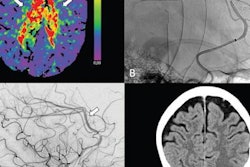
How do academic and private interventionalists compare when it comes to work measures such as compensation or call time? Private practice interventional radiologists may have an edge, according to a study published October 17 in the Journal of the American College of Radiology.
The study findings address a knowledge gap regarding interventional radiology, for which practice characteristics have not been much examined, study lead author Dr. Lola Oladini of Stanford School of Medicine told AuntMinnie.com.
"The nuances of private practice interventional radiology jobs versus academic [ones] have been a bit of a 'black box,'" she said. "Data suggests that up to 80% of interventional radiology trainees pursue private practice jobs, and we wanted to explore in granular detail the major differences in practice structure so that interventional radiologists currently in practice could compare their practice case mix, productivity, and salary to a decently generalizable sample to know where they fall and where areas of opportunity exist within their practice."
To bridge the knowledge gap, Oladini's group conducted a study that included data from a 60-question survey completed by 357 American interventional radiologists who were contacted via the Society of Interventional Radiologists (SIR).
The team found that among 84 interventional private practice radiology groups, there was a trend for higher annual work relative value units per clinical full-time equivalent compared with interventional radiologists working in academic settings, but this difference was not statistically significant.
| Work characteristics between academic and private radiology practices | ||
| Measure | Academic radiology practices | Private radiology practices |
| Percentage of production of total annual work relative value units (wRVUs) | 7% | 26% |
| Median weekly hours | 52 | 50 |
| Frequency of call | 5 days | 6 days |
| Buying and selling of call shifts | 25% | 58% |
| Annual compensation | $451,000 | $573,000 |
| Annual paid vacation (median) | 6 weeks | 10 weeks |
The authors noted that academic practices had higher case percentages in interventional oncology and hepatobiliary interventions compared to private practices, while private practices demonstrated higher percentages of musculoskeletal interventions and a non-statistically significant trend for stroke and neuroradiology interventions.
"Given differing expectations and priorities with variable practice types and settings, the interventional radiology community at large [benefits] from a survey of its members attempting to self-quantify differences in practice structure, productivity, and compensation," Oladini and colleagues concluded.




















